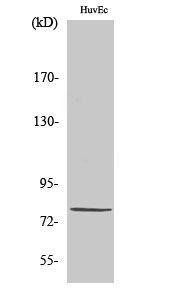PIAS 1 Polyclonal Antibody
- 产品详情
- 实验流程
- 背景知识
Application
| WB, IHC-P |
|---|---|
| Primary Accession | O75925 |
| Reactivity | Human, Mouse |
| Host | Rabbit |
| Clonality | Polyclonal |
| Calculated MW | 71836 Da |
| Gene ID | 8554 |
|---|---|
| Other Names | PIAS1; DDXBP1; E3 SUMO-protein ligase PIAS1; DEAD/H box-binding protein 1; Gu-binding protein; GBP; Protein inhibitor of activated STAT protein 1; RNA helicase II-binding protein |
| Dilution | WB~~Western Blot: 1/500 - 1/2000. Immunohistochemistry: 1/100 - 1/300. ELISA: 1/10000. Not yet tested in other applications. IHC-P~~N/A |
| Format | Liquid in PBS containing 50% glycerol, 0.5% BSA and 0.09% (W/V) sodium azide. |
| Storage Conditions | -20℃ |
| Name | PIAS1 |
|---|---|
| Synonyms | DDXBP1 |
| Function | Functions as an E3-type small ubiquitin-like modifier (SUMO) ligase, stabilizing the interaction between UBE2I and the substrate, and as a SUMO-tethering factor (PubMed:11583632, PubMed:11867732, PubMed:14500712, PubMed:21965678, PubMed:36050397). Catalyzes sumoylation of various proteins, such as CEBPB, MRE11, MTA1, PTK2 and PML (PubMed:11583632, PubMed:11867732, PubMed:14500712, PubMed:21965678, PubMed:36050397). Plays a crucial role as a transcriptional coregulation in various cellular pathways, including the STAT pathway, the p53 pathway and the steroid hormone signaling pathway (PubMed:11583632, PubMed:11867732). In vitro, binds A/T-rich DNA (PubMed:15133049). The effects of this transcriptional coregulation, transactivation or silencing, may vary depending upon the biological context (PubMed:11583632, PubMed:11867732, PubMed:14500712, PubMed:21965678, PubMed:36050397). Mediates sumoylation of MRE11, stabilizing MRE11 on chromatin during end resection (PubMed:36050397). Sumoylates PML (at 'Lys-65' and 'Lys-160') and PML-RAR and promotes their ubiquitin-mediated degradation (By similarity). PIAS1-mediated sumoylation of PML promotes its interaction with CSNK2A1/CK2 which in turn promotes PML phosphorylation and degradation (By similarity). Enhances the sumoylation of MTA1 and may participate in its paralog- selective sumoylation (PubMed:21965678). Plays a dynamic role in adipogenesis by promoting the SUMOylation and degradation of CEBPB (By similarity). Mediates the nuclear mobility and localization of MSX1 to the nuclear periphery, whereby MSX1 is brought into the proximity of target myoblast differentiation factor genes (By similarity). Also required for the binding of MSX1 to the core enhancer region in target gene promoter regions, independent of its sumoylation activity (By similarity). Capable of binding to the core enhancer region TAAT box in the MYOD1 gene promoter (By similarity). |
| Cellular Location | Nucleus {ECO:0000250|UniProtKB:O88907}. Nucleus speckle Nucleus, PML body {ECO:0000250|UniProtKB:O88907}. Cytoplasm, cytoskeleton. Note=Interaction with CSRP2 may induce a partial redistribution along the cytoskeleton (PubMed:11672422). Interaction with MSX1 is required for localization to the nuclear periphery (By similarity) {ECO:0000250|UniProtKB:O88907, ECO:0000269|PubMed:11672422} |
| Tissue Location | Expressed in numerous tissues with highest level in testis. |
For Research Use Only. Not For Use In Diagnostic Procedures.
Provided below are standard protocols that you may find useful for product applications.
BACKGROUND
Functions as an E3-type small ubiquitin-like modifier (SUMO) ligase, stabilizing the interaction between UBE2I and the substrate, and as a SUMO-tethering factor. Plays a crucial role as a transcriptional coregulation in various cellular pathways, including the STAT pathway, the p53 pathway and the steroid hormone signaling pathway. In vitro, binds A/T-rich DNA. The effects of this transcriptional coregulation, transactivation or silencing, may vary depending upon the biological context. Sumoylates PML (at'Lys-65' and 'Lys-160') and PML-RAR and promotes their ubiquitin-mediated degradation. PIAS1-mediated sumoylation of PML promotes its interaction with CSNK2A1/CK2 which in turn promotes PML phosphorylation and degradation (By similarity). Enhances the sumoylation of MTA1 and may participate in its paralog-selective sumoylation. Plays a dynamic role in adipogenesis by promoting the SUMOylation and degradation of CEBPB (By similarity).
终于等到您。ABCEPTA(百远生物)抗体产品。
点击下方“我要评价 ”按钮提交您的反馈信息,您的反馈和评价是我们最宝贵的财富之一,
我们将在1-3个工作日内处理您的反馈信息。
如有疑问,联系:0512-88856768 tech-china@abcepta.com.























 癌症的基本特征包括细胞增殖、血管生成、迁移、凋亡逃避机制和细胞永生等。找到癌症发生过程中这些通路的关键标记物和对应的抗体用于检测至关重要。
癌症的基本特征包括细胞增殖、血管生成、迁移、凋亡逃避机制和细胞永生等。找到癌症发生过程中这些通路的关键标记物和对应的抗体用于检测至关重要。 为您推荐一个泛素化位点预测神器——泛素化分析工具,可以为您的蛋白的泛素化位点作出预测和评分。
为您推荐一个泛素化位点预测神器——泛素化分析工具,可以为您的蛋白的泛素化位点作出预测和评分。 细胞自噬受体图形绘图工具为你的蛋白的细胞受体结合位点作出预测和评分,识别结合到自噬通路中的蛋白是非常重要的,便于让我们理解自噬在正常生理、病理过程中的作用,如发育、细胞分化、神经退化性疾病、压力条件下、感染和癌症。
细胞自噬受体图形绘图工具为你的蛋白的细胞受体结合位点作出预测和评分,识别结合到自噬通路中的蛋白是非常重要的,便于让我们理解自噬在正常生理、病理过程中的作用,如发育、细胞分化、神经退化性疾病、压力条件下、感染和癌症。






